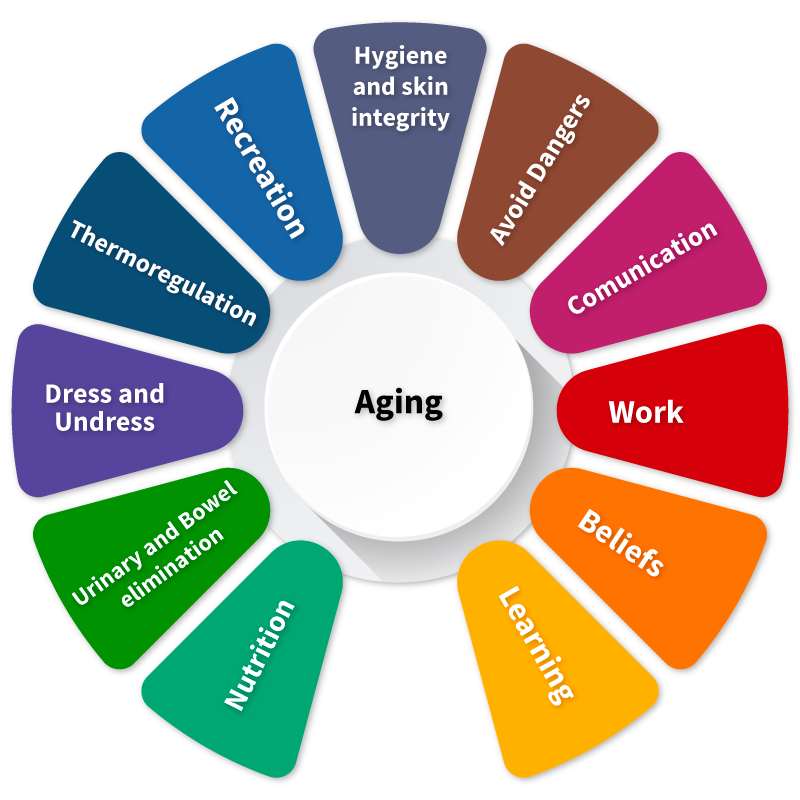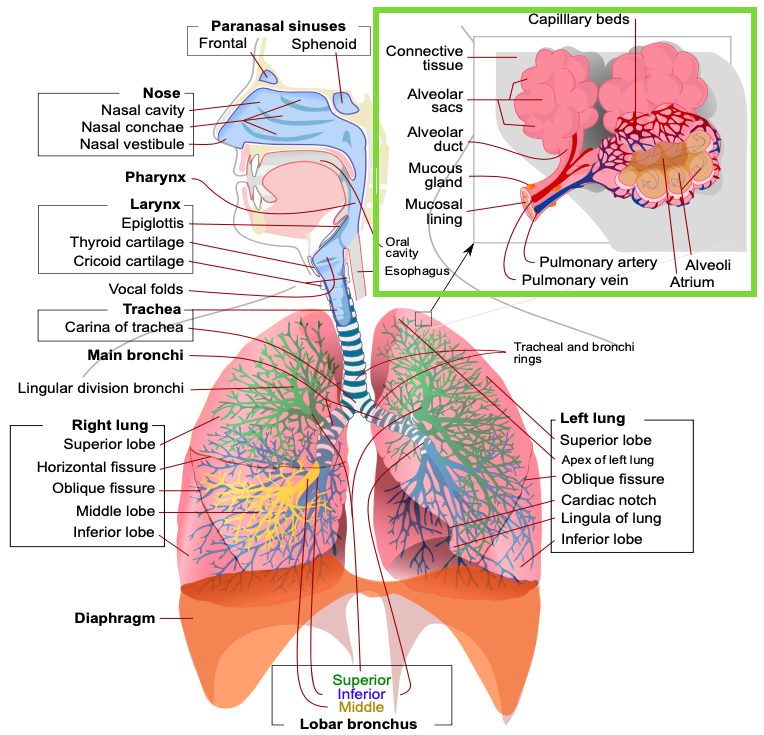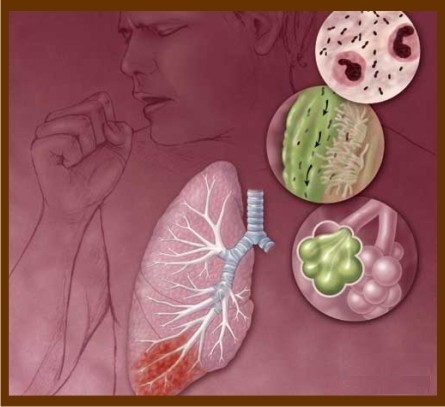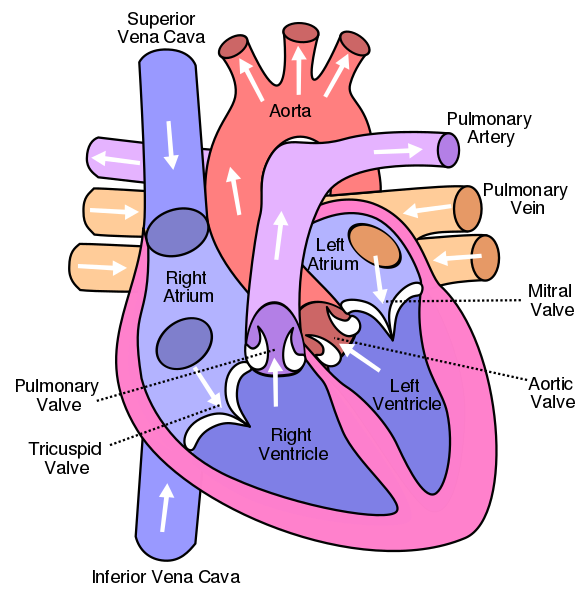Oxigenation in the Elderly
Unidad de Apoyo para el Aprendizaje
Proyecto PAPIME Clave: PE308817
StartFrom the age of 60, a series of anatomical and physiological changes are highlighted in all the systems of the human organism, due to the normal aging process. The changes that occur in the respiratory and cardiovascular systems make it difficult to satisfy the oxygenation need, decreasing the functional capacity of the elderly to move from one place to another.

These changes are manifested through signs and symptoms that show the diminution of the functional capacity of the eldery to carry out their daily activities; in other words, the human being, when aging, presents biological alterations that account for the dependence on the need for oxygenation.
During the assessment of an older adult, the nurse may use devices to identify the present manifestations that hinder oxygenation. As well as employing other devices when providing nursing care to satisfy the need for oxygenation.
Click on the arrows to visualize some questions that may arise during the care.
To provide timely nursing care, it is essential to recognize anatomophysiological changes in the respiratory system of the eldery. In a while you will be able to view a brief description of each one so that you can have the opportunity to detect them.
Click on each anatomophysiological change to display its description.

Wikipedia. (n. d.). Respiratory system [graphic]. Retrieved from: https://commons.wikimedia.org/wiki/File:Respiratory_system_complete_es.svg
With aging, the lungs begin to lose part of the tissue. The number of alveoli and capillaries decreases, as does the elasticity, due to the loss of elastin in the lung tissue.

(n.d.). Respiratory system with bronchopneumonia [image].
Retrieved from: http://blog.daum.net/jusu/420
At the same time, the quantity and mobility of the cilia (hairs) that cover the respiratory tract decreases; therefore, its ability to move mucus up and out of the airways. Consequently, the older adult has difficulty expectorating secretions and tends to accumulate them.

Fundación Ana Vázquez. (2007). Nuevos fármacos, nuevos mecanísmos de acción: bortezomib, un nuevo modelo de tratamiento antineoplásico [Image]. Retrieved from: https://fundacionannavazquez.wordpress.com/2007/11/page/2/
There is also a lower production of immoglobulin A through the respiratory passages. Consequently, this population is at risk of presenting frequent infections.

Napa. (n. d.). Human Anatomy Thorax. (s.l.p.) Human Medicine [image]. Retrieved from http://mirevistamedica.net/Introduccion---Torax.php
A slight increase in the anteroposterior thoracic diameter is observed, due to the loss of between 2.5 and 7.5 cm of height after turning 70. This causes a decrease in the mobility of the ribs and the contraction of the respiratory muscles. Consequently, the elderly breathes superficially and can present a decrease in the number of breaths per minute and vital capacity.

Wikipedia. (2008). Heart diagram [picture]. Retrieved from: https://commons.wikimedia.org/wiki/File:Diagram_of_the_human_heart.svg
There is a slight degeneration of the heart muscle cells, the heart wall and the valves of the heart become rigid. At the same time, there is a decrease in the activity of the cardiac conduction electrical system. Consequently, there is a decrease in the amount of blood ejected and a slower filling of the heart.

Wikipedia. (n. d.). Circulatory system [GIF]. Retrieved from: https://en.wikipedia.org/wiki/Circulatory_system
There are certain anatomophysiological changes in the respiratory system, coupled with the deficient immune-nutritional status, which make the elderly vulnerable to the presence of respiratory infections, which affect lung gas exchange.
They are manifested through the presence of rattles and sibilant wheezes, caused by the accumulation of secretions in the airways as the air passes. They are heard as if blowing in a glass of water; that is, a bubbling sound or a whistling sound is heard.

Angmar, D. (2017). Neumonía, proceso de atención de enfermería [Image]. Retrieved from: https://www.slideshare.net/witchkingangmar/neumonia-proceso-de-atencion-de-enfermeria-84675936
Also, the accumulation of secretions in the respiratory tract hinders the oxygenation of the tissues, manifesting with cyanosis or a bluish color in the lips and nail beds and, in general, in the skin and mucous membranes.

Wikipedia. (2010). Ischemia [picture]. Retrieved from: https://commons.wikimedia.org/wiki/File:Ischemia.JPG
Ronzón, D. (2012). Cyanosis prevention [picture]. Retrieved from: http://prevenciondecianosis.blogspot.com/
Mi Diario. (n. a.). Cardiac! Paying attention to these signals could sabe your life [picture]. Retrieved from: http://autoria.midiario.com/uhora/sexo-y-salud/cardiaco-presta-atencion-estas-senales-podrian-salvarte-la-vida
Due to the anatomophysiological changes in the respiratory system, the oxygenation capacity in the eldery decreases, causing tiredness and fatigue; even so, the eldery can perform the activities of daily life. However, in the presence of a respiratory health problem he or she will have difficulty performing them.

Pxhere. (2017). Headache [picture]. Retrieved from https://pxhere.com/es/photo/1048705
According to the NANDA (2015), the identification of nursing diagnoses that occur most frequently are:

Pixabay. (n. d.). Patient chart [vector]. https://pixabay.com/illustrations/prognosis-icon-patient-chart-2803190/ |
Risk of respiratory infection |
Condition of vulnerability to an invasion and multiplication of pathogenic organisms (in the respiratory system) that can compromise health status. |
Ineffective Breathing Pattern |
Inspiration or expiration that does not provide adequate ventilation. | |
Ineffective Airway Clearance |
Inability to eliminate secretions or obstructions of the respiratory tract to maintain permeable airways. |
Next, you will be given a case in which the patient, with this health problem, receives information about care through devices in order to satisfy the need for oxygenation in the elderly, and explains some of the interventions performed by the nursing area.
Click on the arrows or bullets to visualize what is happening on each stage of the case.
Based on the previous case, you could notice of the different interventions that the nurse performs; from the assessment to the planning of interventions that satisfy the need for oxygenation of the patient.
The aging process changes naturally in the respiratory and cardiovascular system. However, there are certain manifestations that are related to health problems and it is necessary to differentiate them during nursing care in the need for oxygenation.
According to the explanation of this difference, it responds to what are the following statements to verify that they comply with a normal change in the aging process, or a manifestation of dependence on the need for oxygenation of the elderly. It is essential that you get to be able to identify a normal change and not confuse it with a dependence manifestation to offer the corresponding treatment.
Each care and device fulfills a particular function during the process of assistance in the need for oxygenation of the elderly.
It is essential to recognize what are the normal changes in the aging process and what are the manifestations that happen to the eldery in need of oxygenation. Based on this difference you can provide adequate nursing care.
Information Sources
Bibliography
NANDA. (2015). NANDA Internacional Diagnósticos Enfermeros. Definición y Clasificación 2015-2017. Barcelona: Elsevier.
Reyes, A. (2017). Atención de Enfermería para el cuidado del adulto mayor en el hogar. México: ENEO-UNAM.
Electronic sources
Codinardo, C., Cáneva, J. O., Montiel, G., Uribe, M. E., Lisanti, R., Larrateguy, L., et ál. (2016). Recomendaciones sobre el uso de oxigenoterapia en situaciones especiales. Revista Americana de Medicina Respiratoria, 16(2). Retrieved on june 17 of 2018: http://www.scielo.org.ar/scielo.php?script=sci_arttext&pid=S1852-236X2016000200006
Fernández, A. y Fernández, A. (2007). Manual de ayuda a la oxigenación. Dispositivos y procedimientos. Madrid, España: Difusión Avances de Enfermería.
García, M., Molero, M., Moraleda, L. y Pedraza, A. (2015). Cuidados básicos para la edad avanzada. Madrid, España: Difusión Avances de Enfermería.
Sociedad Española de Geriatría y Gerontología. (2007). Tratado de Geriatría para residentes. Madrid: Sociedad Española de Geriatría y Gerontología.
How to quote
Reyes, V. & Tapia, B. (2018). Oxigenation in the elderly. Unidades de Apoyo para el Aprendizaje. CUAED/ENEO-UNAM. Retrieved on (date) from (link)